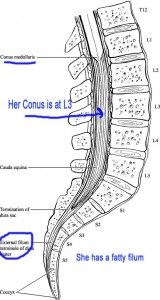May 17!
That’s the day. Of course, I would like for it to be tomorrow so that we can be done, but this is the earliest we could schedule. The doctor called me yesterday (to save me a trip to clinic…how nice?). He explained in great detail (indulging the science-mommy) how he would release the filum. He assured me that the girl would be able to wear a bikini one day because he had studied with a plastic surgeon. I didn’t tell him that I thought that the girl’s daddy would have more of a say in that decision than a little scar! Bikinis aside, the horizontal type of incision that the surgeon will use heals better than the vertical incision. That’s always good! After our discussion, I feel even more confident in this surgeon and that God led us to him.
The surgery will be at Children’s (too bad the new hospital isn’t open yet), and the girl will be in the hospital for 3-4 days. When we get home, we will spend 2 weeks as a couch potato. She can get up 5 times a day for 30 minutes. The girl has such a high pain tolerance, that I imagine keeping her still will be the hardest part. I guess we will read every book in the library, and watch a lot of PBS! After all of the rest, we can work on getting strong again at PT!
Now we wait. We are going to try to do as many fun things as we can over the next two weeks. We will visit our Nana and our friends in Indiana and run around, ride a tractor, and pet the sheep. The girl’s Nonnie is coming, and we will find all kinds of trouble with her. We will have as many play dates with our friends as possible, and for sure we will plant flowers with Aunt J. We will also practice the cello and keep working on our goal of learning “Monkey Song”.
I will post more later about the procedure – for those who would like to know the details.

